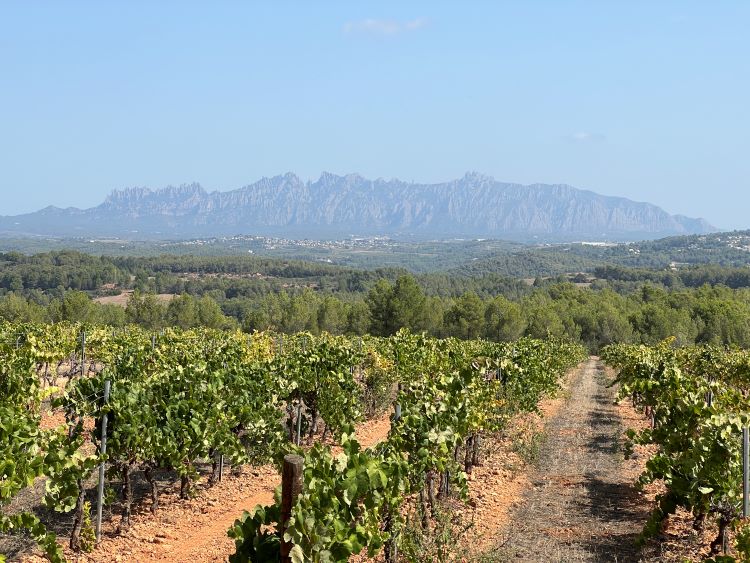Catalonia’s sparkling wine industry in search of climate change countering solutions
Cellars favor traditional Mediterranean grapes, harvest at night, and build structures for shade

High temperatures have broken records in 2022, even surpassing 40ºC in some parts of Catalonia. The temperature increase compared to previous years is putting the future of Cava, one of the territory’s most internationally-renowned drinks, at risk.
Grape growing conditions are constantly changing, forcing winemakers to search for new solutions to save the industry.
"This year, despite the extreme heat, we have yet not reached 40ºC in this area," Ton Mata, CEO of the Recaredo wine cellar and president of Corpinnat label said to Catalan News.
Corpinnat is a group of 11 cellars from the heart of the Penedès wine region that make organic sparkling wine - not Cava, although they follow the same traditional method - that is aged for at least 18 months.
We met on a sunny and warm Tuesday morning to visit Recaredo’s vineyards. The company is a 1924 family-owned winery based in Sant Sadurní d’Anoia, 40 kilometers south of Barcelona.
"This year the harvest is being really hard because the yield is very low," Ton Mata explained. “We have had an important dry period this year but also very high temperatures.”
It is not only the heat but also drought that directly affects cellars. Companies have seen their production levels drop compared to what they had initially expected, making production costs higher than planned.
Listen to our Filling the Sink podcast episode to learn more about the issues cellars in Penedès encounter when making Cava.
Earlier harvests, and at night
Higher temperatures make grapes ripen earlier, meaning that harvests now start earlier than in the past.
"The high temperatures in June sped up the grapevine cycle and forced us to start harvesting a week earlier compared to what was normal in recent years," Joan Esteve, from Raimat, a Cava cellar located in the inland Lleida area, told the the Catalan News Agency (ACN).
Starting the harvest earlier in the summer means fruit pickers are exposed to longer days in the sun, hand-picking grapes before they are pressed. To avoid this, some cellars have already started harvesting at night with tractors that are equipped with large lights to illuminate the vineyards, while each fruit collector hand-picks the grapes while wearing a head torch.
Long-term solutions
Harvesting at night or starting the harvest earlier in August is just a short-term solution for winemakers. In fact, in 2022, some cellars started collecting the grapes up to 10 days earlier than usual.
However, these options will not help Cava or sparkling wine manufacturers cope with the climate emergency. To find a solution, some have decided to stop planting Northern European grape varieties, such as Chardonnay or Pinot Noir.
"We are planting more grapes that can resist heatwaves better, and the hard and hot weather in summer, like Xarel·lo, for instance, which can resist much better than Macabeu," Mata said.
Xarel·lo and Macabeu are two traditional Catalan white grape varieties that ripern later on in the season.
"We are planting long-cycle grapes, the ones whose harvest time arrives later, for instance, Mediterranean grapes," Mata added.
Climate conditions are constantly changing making it more difficult for cellars to plan well in advance. When a vine is planted, it can take up to five years for the first grapes to be harvested.
Therefore, decisions have to be well studied to ensure the survival of the vines and the product in the long term. Recaredo, for example, is already planting vineyards at higher altitudes to see the product and to start experimenting with the grapes.
Sun, shade, and irrigation
Catalonia does not lack sun hours. In fact, they have enough that winemakers are currently looking for ways to increase the hours of shade.
One of the options so far is "putting shades on the vineyards," he said. It would come in the form of structures "similar to the ones used to avoid the hail, but just to have more hours of shade," he added.
This sun-hours reduction would help keep the soil moist favoring a healthier vineyard in a more organic way.
Humidity is key for a healthy crop, prompting cellars to look for ways to maintain the moisture as long as possible, such as with mulch, without having to use an irrigation system, at least for now, as doing so "will not be sustainable," the president of Corpinnat said.
The future is uncertain, and, in Mata’s words, cellars are "really scared about the change of the climate." With higher temperatures and less rainfall, it means "that the plant is suffering and we have fewer grapes.”
Climate change also makes sparkling wine more expensive: low yields requiring innovative fixes and laborious conditions increases production costs, which could eventually affect the final customer.